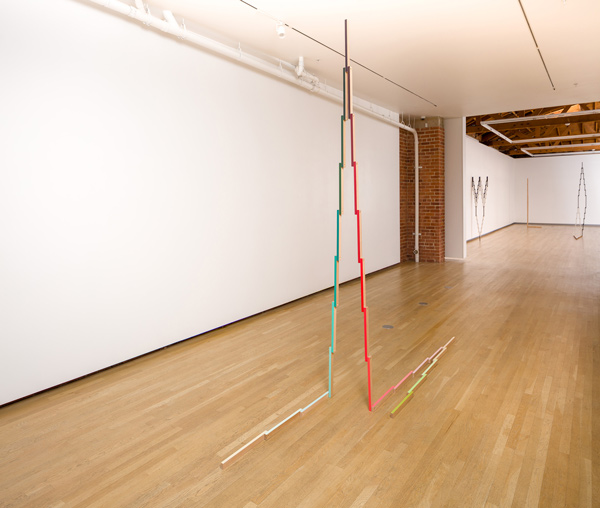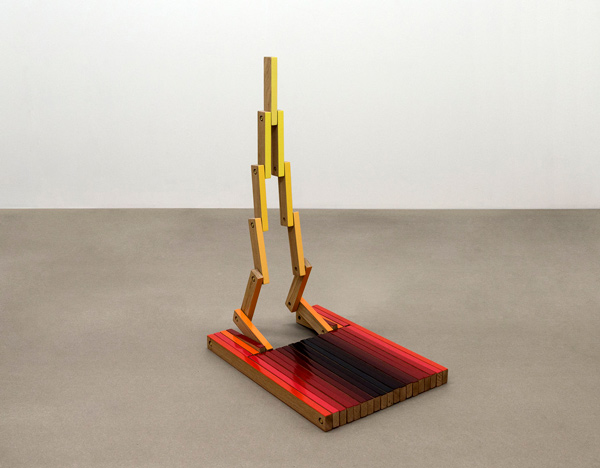Reuven Israel’s compelling exhibition at Shulamit Nazarian, titled “In Four Acts,” is concerned with variation and transformation. His beautifully crafted floor-based sculptures are amalgamations of pieces of painted oak of approximately 6 to 12 inches in length by 1 1/2 inches in height and 3/4 inches in width. A single sculpture often contains more than forty segments, hinged together with brass hardware, allowing the segments to be reconfigured. The sides and ends of each segment are unpainted, while the tops and bottoms are colored to form a gradient.

Reuven Israel, “In Four Acts,” 2018. Installation view, courtesy of the artist and Shulamit Nazarian.
The premise is that the exhibition changes over time, as the sculptures morph from compact rectangles to open and expansive lines, occupying more and more space in the gallery. In their initial state the sculptures (all Untitled Folding Object [#], 2018) stand about an inch and a half off the floor. Like a folding ruler, the individual units can swivel up or down. Israel unfolds them in different ways—in some configurations they becoming towering lines that extend toward the ceiling. In others they resemble human forms (with the geometry of Joel Shapiro sculptures).

Reuven Israel, “In Four Acts,” 2018. Installation view, courtesy of the artist and Shulamit Nazarian.
The artist’s intention is for viewers to notice the way the relationships between negative and positive space change and how the works create a dialogue with the gallery architecture. Though the pieces are not interactive in a way that allows viewers to witness their transformations or to directly effect changes to their configurations, the exhibition’s four distinct stages makes it easy to imagine infinite possibilities. In this regard, Israel’s installation is both minimal and maximal. It recalls works by artists such as Robert Morris or Sol LeWitt who explored different permutations within fixed parameters. The work also calls to mind Channa Horwitz, whose highly structured drawings explored linear progression and systems.

Reuven Israel, Untitled Folding Object 55A (2018). Oak, paint and brass hardware, 23.5 inches wide, height and depth variable. Courtesy of the artist and Shulamit Nazarian.
At one point, both Untitled Folding Object 55A and 36A resembled figures connected to a colorful low base. When extended, these interlocking configurations grow exponentially across the floor or up, becoming triangle shaped towers. Israel’s works derive from mathematical algorithms. As simple as they appear, their architectural structure is complex, with a segmented base that allows for myriad possibilities. In the end, the expanded pieces are like three dimensional line drawings that can become almost anything within this fixed system.
Reuven Israel, “In Four Acts,” November 3 – December 20, 2018, at Shulamit Nazarian, 616 N La Brea Avenue, Los Angeles, California 90036. www.shulamitnazarian.com


